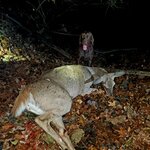DawnPatrol
WKR
Had an experience this week that’s worth sharing:
My buddy shoots at a bull at last light. It’s a quartering away shot. Off hand. At maybe 80 yards. She shoots a .30-06, uses factory Barnes Vortex ammo with 165 gr. bullets.
The bull runs off, without visibly reacting to the shot. After waiting 30 minutes, we start tracking. It’s full-on dark and there’s three of us with head lamps. There’s no blood at the site of the shot. The tracks show the bull (and another that was with it) headed down hill and then up another ridge.
The tracks are mostly in mud and ponderosa pine needles, but the bulls did cross a dry rocky wash and several bare logs—all of which would have been good to places to see blood. But after tracking for 2 hours over about 300 yards and never seeing a drop of blood, we decide to pack it in and return in the morning.
The lack of blood, along with no beds in the track and the bull keeping pace with his non-wounded companion, led us to think there had been a clean miss or at least a poor hit. Spirits were pretty low in camp that night.
Back on the track at first light the next day. My buddy spots about 3 more tracks, then looks up and spots her bull piled up just 50 yards ahead!! Even right where he went down, we found no blood.
After cutting up the bull, it looked as though the bullet had gone in the through the guts, destroyed the off-side lung, but not made an exit wound. The elk had bled out internally, but no blood made it out the entrance wound.
It seems likely the bull died quickly—if it had been alive the night before we almost certainly would have bumped it.
Anyway, I guess the takeaway for me is: even if I don’t see an elk react to the shot or see blood on the ground, keep tracking and looking hardbecause they can go a long ways without bleeding and still die.
My buddy shoots at a bull at last light. It’s a quartering away shot. Off hand. At maybe 80 yards. She shoots a .30-06, uses factory Barnes Vortex ammo with 165 gr. bullets.
The bull runs off, without visibly reacting to the shot. After waiting 30 minutes, we start tracking. It’s full-on dark and there’s three of us with head lamps. There’s no blood at the site of the shot. The tracks show the bull (and another that was with it) headed down hill and then up another ridge.
The tracks are mostly in mud and ponderosa pine needles, but the bulls did cross a dry rocky wash and several bare logs—all of which would have been good to places to see blood. But after tracking for 2 hours over about 300 yards and never seeing a drop of blood, we decide to pack it in and return in the morning.
The lack of blood, along with no beds in the track and the bull keeping pace with his non-wounded companion, led us to think there had been a clean miss or at least a poor hit. Spirits were pretty low in camp that night.
Back on the track at first light the next day. My buddy spots about 3 more tracks, then looks up and spots her bull piled up just 50 yards ahead!! Even right where he went down, we found no blood.
After cutting up the bull, it looked as though the bullet had gone in the through the guts, destroyed the off-side lung, but not made an exit wound. The elk had bled out internally, but no blood made it out the entrance wound.
It seems likely the bull died quickly—if it had been alive the night before we almost certainly would have bumped it.
Anyway, I guess the takeaway for me is: even if I don’t see an elk react to the shot or see blood on the ground, keep tracking and looking hardbecause they can go a long ways without bleeding and still die.

